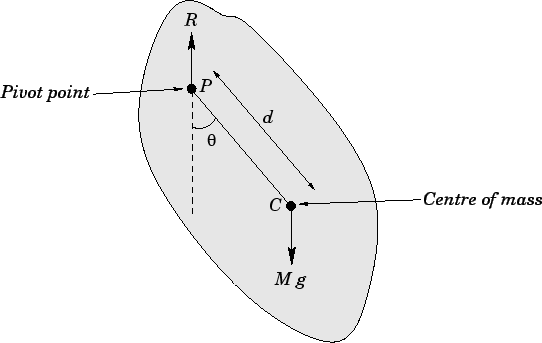


Next: Uniform circular motion
Up: Oscillatory motion
Previous: The simple pendulum
Consider an extended body of mass  with a hole drilled though it. Suppose that the body is suspended
from a fixed peg, which passes through the hole, such that it is free to swing from side to side,
as shown in Fig. 98. This setup is known as a compound pendulum.
with a hole drilled though it. Suppose that the body is suspended
from a fixed peg, which passes through the hole, such that it is free to swing from side to side,
as shown in Fig. 98. This setup is known as a compound pendulum.
Figure 98:
A compound pendulum.
 |
Let  be the pivot point, and let
be the pivot point, and let  be the body's centre of mass, which is located a distance
be the body's centre of mass, which is located a distance  from the
pivot. Let
from the
pivot. Let  be the angle subtended between the downward vertical (which passes through point
be the angle subtended between the downward vertical (which passes through point  ) and the
line
) and the
line  . The equilibrium state of the compound pendulum corresponds to the case in which the centre of
mass lies vertically below the pivot point: i.e.,
. The equilibrium state of the compound pendulum corresponds to the case in which the centre of
mass lies vertically below the pivot point: i.e.,  . See Sect. 10.3.
The angular equation of motion of the pendulum is simply
. See Sect. 10.3.
The angular equation of motion of the pendulum is simply
 |
(529) |
where  is the moment of inertia of the body about the pivot point, and
is the moment of inertia of the body about the pivot point, and  is the torque.
Using similar arguments to those employed for the case of the simple pendulum (recalling that all
the weight of the pendulum acts at its centre of mass), we can write
is the torque.
Using similar arguments to those employed for the case of the simple pendulum (recalling that all
the weight of the pendulum acts at its centre of mass), we can write
 |
(530) |
Note that the reaction,  , at the peg does not contribute to the torque, since its line of action passes
through the pivot point.
Combining the previous two equations, we obtain the following angular equation of motion of the pendulum:
, at the peg does not contribute to the torque, since its line of action passes
through the pivot point.
Combining the previous two equations, we obtain the following angular equation of motion of the pendulum:
 |
(531) |
Finally, adopting the small angle approximation,
 , we arrive at the
simple harmonic equation:
, we arrive at the
simple harmonic equation:
 |
(532) |
It is clear, by analogy with our previous solutions of such equations, that the angular frequency of small
amplitude oscillations of a compound pendulum is given by
 |
(533) |
It is helpful to define the length
 |
(534) |
Equation (533) reduces to
 |
(535) |
which is identical in form to the corresponding expression for a simple pendulum. We conclude that a
compound pendulum behaves like a simple pendulum with effective length  .
.



Next: Uniform circular motion
Up: Oscillatory motion
Previous: The simple pendulum
Richard Fitzpatrick
2006-02-02

![]() be the pivot point, and let
be the pivot point, and let ![]() be the body's centre of mass, which is located a distance
be the body's centre of mass, which is located a distance ![]() from the
pivot. Let
from the
pivot. Let ![]() be the angle subtended between the downward vertical (which passes through point
be the angle subtended between the downward vertical (which passes through point ![]() ) and the
line
) and the
line ![]() . The equilibrium state of the compound pendulum corresponds to the case in which the centre of
mass lies vertically below the pivot point: i.e.,
. The equilibrium state of the compound pendulum corresponds to the case in which the centre of
mass lies vertically below the pivot point: i.e., ![]() . See Sect. 10.3.
The angular equation of motion of the pendulum is simply
. See Sect. 10.3.
The angular equation of motion of the pendulum is simply